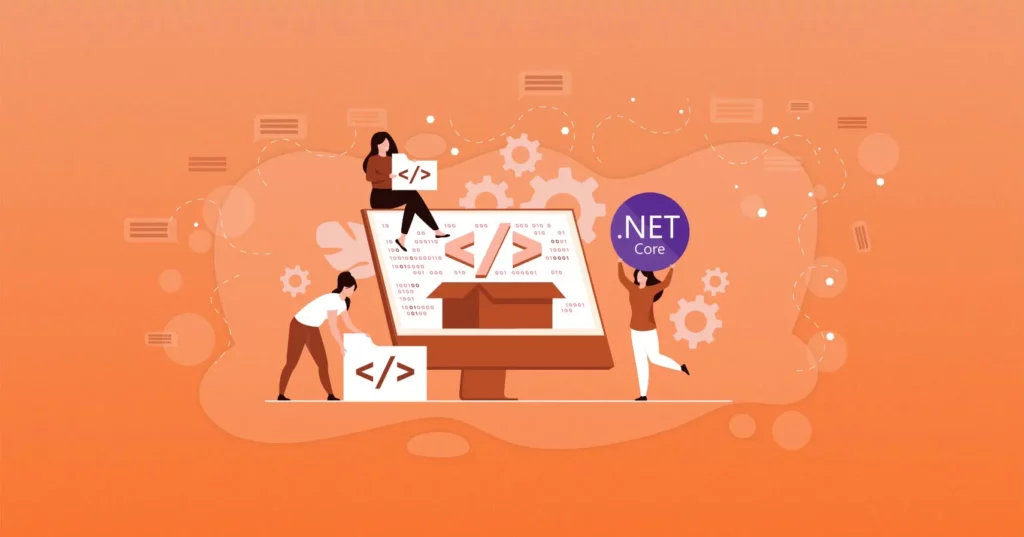Top 15 .Net Core Interview Questions and Answers in [UPDATED 2024]

Table of content
According to Wikipedia, .”NET Core” is a managed computer program framework that is free and open-source for the Windows, Linux, and macOS operating systems. It is the cross-platform replacement for the .NET Framework. The project was created largely by Microsoft workers under the .NET Foundation and is licensed under the MIT License.
Before we get into the meat of this .Net Core interview questions and answers, let’s go through what we’re going to tackle in this article.
![.Net Core Interview Questions [Infographic]](https://uploads-ssl.webflow.com/60191dad58754e0475bdfbcf/620ccfb788958a9a179a47e8_Top%2015%20.Net%20Core%20Interview%20Questions%20and%20Answers%20in%20%5BUPDATED%202022%5D%20(1).png)
Now that we’ve defined what. Net core is, it’s worth noting that. Net Core interview questions are regarded as some of the most challenging job interview questions ever. Yet, our experienced recruiting managers went above and beyond to make this possible. NET Core interview questions and give the best response for each.
Please keep in mind that these .Net Core interview questions and answers are intended to help you in acing your job interview with ease. But, it might be worthwhile to exert additional research in order to discover other .Net Core interview questions and answers to improve your chances of landing your job interview.
TOP 15 .Net Core Interview Questions and Answers in 2024
The following is the top .Net Core interview questions and answers that will give you a big hand in the preparation process. As mentioned before, every question is carefully selected by professional hiring managers with years of experience in the field.
What are some of the characteristics of .NET Core?

- Flexible deployment. It can be integrated into your app or deployed separately on each user or computer.
- Cross-platform. It runs on Windows, Mac OS X, and Linux, and it may be adapted to other operating systems. Microsoft, other businesses, and people will add to the list of supported Operating Systems (OS), CPUs, and application situations over time.
- Command-line utilities. On the command-line, you may test all product scenarios.
- The .NET Standard Library makes.NET Core interoperable with the.NET Framework, Xamarin, and Mono.
- The source code is freely available online. The .NET Core platform is available under the MIT and Apache 2 licenses and is free to use. The documentation is licensed under the Creative Commons Attribution-Noncommercial-No Derivative Works 3.0 Unported License. .NET Core is a project of the.NET Foundation.
- Microsoft’s .NET Core is supported, according to the .NET Core Support page.
What is CTS?
The Common Type System (CTS) unifies the data types of all programming languages that use .NET under the .NET umbrella into a single data type for easy and seamless communication. With System, CTS is built as a single-rooted object hierarchy. The fundamental type from which all other types are derived is “Object”. Types are supported by CTS in two ways: – Types of Values: Values that must be stored directly on the stack or allocated inline in a structure are stored here. They can be built-in (standard primitive types), user-defined (source code specified), or enumerated (sets of enumerated values that are represented by labels but stored as a numeric type).
What is Zero Garbage Collectors?
The Zero Garbage Collectors is the most basic solution available, and it does virtually nothing. It only permits you to allocate objects because the Execution Engine clearly requires it. Objects created are never automatically destroyed, and no memory that is no longer needed is ever recovered.
Explain a simple GC implementation?
It’s a great starting point for creating your own garbage collection system. You can build on top of it because it offers the essential features to make runtime operate properly.
It may be useful for specific use situations, such as relatively short-lived programs or ones that need less memory allocation (you can come up with those concepts as No-alloc or Zero-alloc programming). In this situation, supplying GC overhead is superfluous, and it would be preferable to do away with it. It’s the equivalent of building a massive GC. Throughout your program, use StartNoGCRegion.
When does Garbage collection occur?
When one of the following conditions is met, garbage pickup takes place.
- Physical memory is limited on this machine.
- The amount of memory utilized by allocated objects on the managed heap exceeds the allowed limit. As the process progresses, this threshold is changed on a regular basis.
- The GC.Collect function is called, and you virtually never need to use it because the garbage collector operates in the background. This approach is mostly used for testing and unusual circumstances.
What is unit testing?
Unit testing is a software development technique that focuses on the smallest testable components of a program, known as units. They are examined separately and independently for good operation. Unit testing may be done either manually or automatically.
What are Empty migrations?
It’s sometimes helpful to add a migration without changing the model. Adding a new migration in this scenario results in code files with empty classes. This migration may be customized to execute actions that aren’t directly related to the EF Core model. The following are some items you would wish to manage this way: – Functions – Stored Procedures – Full-Text Search – Views – Triggers
What are the Differences Between .net Core and .net Framework?
The following three points highlight the differences between the two:
NuGet-based: .NET Core is offered as a series of NuGet packages that may be used to deploy apps locally. The .NET Framework, on the other hand, is always installed at a system-wide place. This distinction is less important for class libraries, but it is significant for applications, which must deploy the closure of their dependencies. But, we expect that this paradigm will affect how quickly class library developers may provide new features. There is less of a penalty for component developers to take advantage of the latest capabilities because the applications may simply deploy a new version (rather than needing to wait until a given .NET Framework version is widely accepted).
Well layered: .NET Core was created with the intention of being layered. The objective was to develop a .NET stack that could deal with a wide range of capabilities and system restrictions without requiring customers to recompile binaries or generate new assets. As a result, certain APIs had to be removed since they linked lower-level components to higher-level components. In such instances, we offer alternatives, which are frequently in the form of extension techniques.
Free of problematic tech: AppDomain and sandboxing, for example, are not included in .Net Core since we opted to remove them because they were troublesome. Our aim is to have replacements if the case still makes sense for.NET Core. AssemblyLoadContext, for example, substitutes AppDomains for loading and isolating assemblies.
What are complex and supporting methods?
Pay attention because this is one of the most challenging .Net Core interview questions of all time.
- The System is in place. Numerics. A complex number, or one with a real and imaginary component, is represented by the complex type.
- It includes ordinary arithmetic, comparison, equality, explicit and implicit conversion operators, as well as mathematical, algebraic, and trigonometric techniques.
What is FCL?
Framework Class Libraries (FCL) – A Framework Class Library (FCL) is a collection of reusable kinds, such as classes, interfaces, and data types, that are included in the .NET Framework to enable access to system functionality.
What is IGCToCLR interface?
This interface is used to connect with the runtime and is given as an argument to the method InitializeGarbageCollector. It has a large number of possible ways, so mentioning them all here would be unnecessary.
What are ‘Generate SQL scripts’ in .Net Core?
It’s helpful to build a SQL script while troubleshooting or deploying your migrations to a production database. After that, the script may be double-checked for correctness and adjusted to meet the requirements of a production database. Also, the script may be used in conjunction with a deployment technique.
Explain the difference between Task and Thread in .NET
Thread is a real OS thread, complete with its own stack and kernel resources. Threads provide the most flexibility; you may Abort(), Suspend(), or Resume() them, inspect their status, and modify thread-level characteristics like stack size, apartment state, and culture. ThreadPool is a wrapper for a thread pool managed by the CLR.
The Task Parallel Library’s Task class combines the best of both worlds. A job, like the ThreadPool, does not have its own OS thread. Tasks are instead carried out by a TaskScheduler, while the default scheduler merely uses the ThreadPool. Unlike ThreadPool, Task also allows you to check when it ends and return a result (through the generic Task).
When should we use .NET Core and .NET Standard Class Library project types?
This is one of the most challenging .Net Core interview questions. When you wish to expand the number of apps that will be compatible with your library but don’t mind a reduction in the.NET API surface area your library may access, use a .NET Standard library.
When you wish to expand the .NET API surface area your library can access and are comfortable with just allowing.NET Core apps to be compatible with your library, use a.NET Core library.
Explain LINQ.
The term “LINQ” stands for Language Integrated Query, and it was first introduced in Visual Studio 2008. LINQ is a set of features that add additional standard query operators to the .NET language syntax, allowing data manipulation independent of the data source. .NET Framework collections, SQL Server databases, ADO.NET Datasets, XML documents, and any collection of objects in C# or Visual Basic that implement IEnumerable or the generic IEnumerable interface are all supported data sources. LINQ, in a nutshell, bridges the gap between the worlds of objects and data.
By this point, I am certain that you have realized that these. Net Core interview questions are difficult to answer and require extensive interview preparation. We can’t help but bring up Huru when the topic of interview preparation comes up. Huru is an AI-powered job interview coach that uses sophisticated algorithms to help people prepare for job interviews. Through mock interviews that simulate the reality, Huru is able to analyze candidates’ performance in order to spot their shortcomings and places need to be improved.
Huru has introduced a slew of new and innovative features to the employment market, including instant feedback, over 20K mock interviews, a facial expressions analyzer, and more. Huru, on the other hand, takes pleasure in the customized job interview feature, which you may wonder what that is. Candidates can now conduct a personalized job interview depending on the precise job offer they applied for, thanks to Huru’s strong cooperation with leading employment portals like LinkedIn and Indeed. Your unique job interview questions will be determined entirely by the job description you select.
Good Luck.

Elias Oconnor
Senior Copywriter